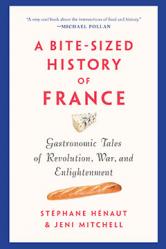AUTHOR SPOTLIGHT: Stéphane Hénaut and Jeni Mitchell
Stéphane was a bit distraught, but he came up with a very clever plan—a bit reminiscent of Talleyrand, that great gastronomic diplomat—and began telling me stories about these cheeses. It turned out that many of them were a thousand years old, created by medieval monks trying to get around their strict religious diets by inventing really interesting cheeses. And he explained how these cheeses taste of their homeland, because they are made with the milk of cows or sheep grazing in one small area, and so to taste this cheese was to consume a part of France itself. And so because I’m a total fool for history, and for France—and in fact, for my husband—I changed my mind and accepted these cheeses into our home (although I am still not that happy to actually eat them myself).
Stéphane thought that was the end of that, but then I started pestering him with questions about everything we ate. And it turns out that, in France, every food and wine has a story—a story of how it was created, about the land and the people who produce it, and sometimes about important historical events and people associated with it. We began collecting these stories, and eventually we realized that if you put them all together, in rough chronological order, you could in fact construct an entire history of France. And so that is really what our book is, a history of France as told through its foods and wines.
Hénaut/Mitchell: We particularly like the chapters that use food to illustrate broader changes in French society, such as our chapters on medieval French cuisine that reveal how food became a marker of class difference and privilege, in ways that are surprisingly reminiscent of attitudes toward food today. I also enjoyed writing our chapter on the transition from medieval to modern French sauces, reflecting everything from the Reformation and the scientific revolution to expanding global trade and the invention of the stove. We have a chapter on how Enlightenment philosophy led people to favor more authentic rustic cuisines, and we explain French revolutionary ideology by showing how it was manifested in the food trades. The social dislocation resulting from industrialization and urbanization is also well captured in gastronomic changes. And we do not shy away from the darker episodes of French history, particularly the French role in European imperialism and the transatlantic slave trade.
We also found it very interesting to research our chapters on everyday French foods, like bread and chocolate and potatoes, which have surprisingly interesting histories that reveal a great deal about French society. Some of the most famous French food items, like cassoulet and croissants and Camembert, can help explain the course of epochal historical events. And some of the most important figures in French history—from Charlemagne to Catherine de’ Medici to Napoleon—have fascinating food legends attached to them that help explain their popular legacies.
And of course, as a cheesemonger, Stéphane particularly enjoyed writing all of our chapters on French cheeses—classics like brie and Roquefort, but also some less familiar cheeses that we hope people will find intriguing.
Hénaut/Mitchell: Terroir is a French concept that tries to capture the connection between gastronomy, territory, and society—how a food or wine is intimately linked to the land and the people who produce it. Roquefort, for example, is a blue cheese that has been produced for perhaps two thousand years in southwestern France, with the milk of sheep who graze only in a very small area, and aged in the caves of one specific mountain. A blue cheese that is produced outside these specifications is simply not Roquefort. The great rivalry between the wines of Bordeaux and Burgundy is deeply rooted in notions of terroir, in the belief that different soils and climates—but also different agricultural and social traditions—are reflected in the character of the wines. The terroir for a Burgundy wine might be limited to one particular hillside. There are French honeys made from bees who only visit the flowers of one specific sand dune on the Atlantic coast, and of course sea salt from Brittany is completely different from the sea salt produced in the Mediterranean.
Interestingly, there is an American foundation for the concept of terroir. The invention of the steamship in the nineteenth century enabled transatlantic crossings in ten days, and unfortunately this made it easier for an American pest called phylloxera to survive the trip and ravage the vineyards of France. The impact was apocalyptic: nearly the entire French wine industry was destroyed. The only solution was to graft American vine stocks, which were resistant to phylloxera, onto French vines, but of course this evoked horror among French winemakers. In the end they had no other choice, and the French wine industry was saved. But French winemakers tried to salvage their prestige by claiming that the true character of French wines derived from their soil and climate, from longstanding winemaking traditions—in short, from everything about the wine that was French, not American. This early concept of terroir spread to many types of food, and it culminated in the introduction of the AOC labeling system in the 1920s, which dictates how a certain food or wine must be produced in order to use its protected trademark name.
Terroir remains a very French concept, but it seems to be increasingly influential in many other countries in recent decades. The slow food movement, for example, has much in common with French notions of terroir, emphasizing the importance of local ecosystems and traditions for the character of specific foods.
Hénaut/Mitchell: One of the major aims of our book is to help explain why food is so important to French society and French identity, and naturally this means it is very important for French politics as well—probably more important than in many other countries. One of the most visible examples of this is the way that right-wing groups in France rely heavily on food to promote their narrow ideas of “French-ness.” They complain about halal food and the absence of pork on school menus, they campaign to evict kebab stands from city centers, they set up tables of wine and sausages at their rallies. Their overall narrative is that France—by which they mean white, Christian France—is under threat from alien forces, and they see gastronomy as an important battlefield. But we hope that our book shows how misguided and hateful this narrative really is. There is no static French nation or identity—throughout centuries of war, migration, innovation, and exploration, French society has evolved immensely, including in the realm of food. In fact, many of the most famous French foods have foreign origins. So at a time when right-wing xenophobia is on the rise across the globe, we think it’s important to challenge these attempts to use food as evidence of a supposedly “pure” and unchanging French identity. It is not based in history or reality.
We have also tried to focus a great deal on the everyday foods and traditions of ordinary French people, and not just on the elevated haute cuisine that usually receives so much attention. For example, in our chapter on the 1970s, we focus not only on the emergence of nouvelle cuisine but on the arrival of McDonald’s on French soil. (It may surprise a lot of people to know that France is the second most profitable market for McDonald’s worldwide.) One of the striking things to emerge from our historical narrative is the stark divide between the diets of the rich and the poor, from medieval times until today. We show that this is not simply due to economics, but to socially constructed ideas about what sorts of food are “noble” or “worthy.” These ideas have political effect, because it is easier to demonize populations who eat the “wrong” kinds of foods.
In short, French gastronomy is a fascinating and ever-evolving social activity, one that reveals a great deal about the French people and how they see the world. If we want to understand contemporary struggles with political extremism, inequality, poverty—problems that afflict France and many other countries today—then it is helpful to consider how they are manifested in the realm of food. We hope our readers will find these explorations as fascinating as we did.



